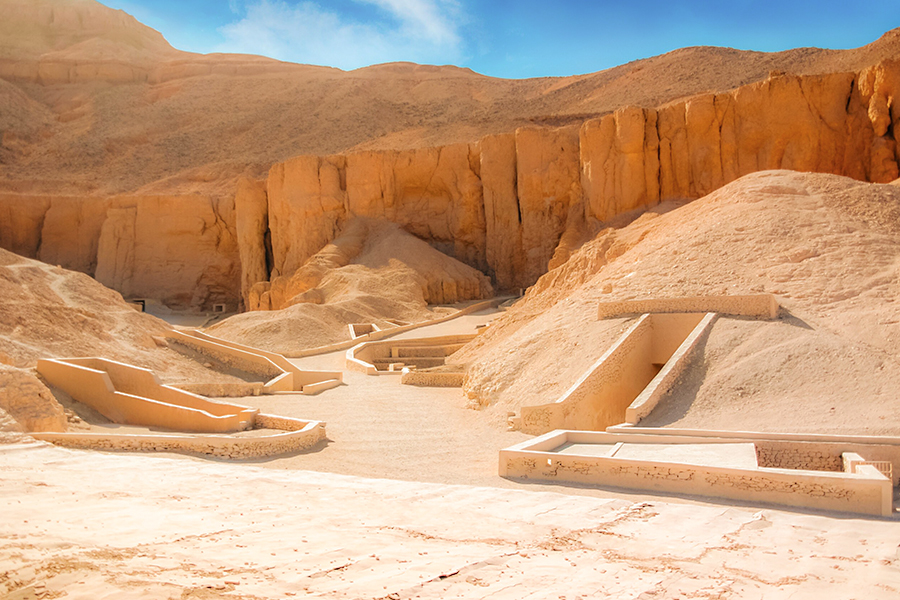Discover the hidden beauty and vibrant colors of the Valley of the Queens, the final resting place of queens, princesses, and noblewomen of ancient Egypt. This sacred valley offers stunning art, powerful feminine energy, and one of the most breathtaking tombs in the world.

Historical Background
Located on Luxor’s West Bank, just south of the Valley of the Kings, the Valley of the Queens (Ta-Set-Neferu)—meaning “The Place of Beauty”—was where queens and royal children of the New Kingdom (1550–1070 BCE) were buried.
Over 90 tombs have been discovered in the valley, belonging to wives of pharaohs from the 18th to 20th Dynasties, as well as several princes and princesses. The most famous is the Tomb of Queen Nefertari, wife of Ramses II—an artistic masterpiece often referred to as the “Sistine Chapel of Ancient Egypt.”
Though less known than the Valley of the Kings, the Valley of the Queens offers a more intimate and less crowded experience, with tombs featuring vivid colors, detailed hieroglyphics, and powerful goddess iconography.
Cultural Significance
This site honors the feminine divine—goddesses like Hathor, Isis, and Maat appear frequently in the wall art, welcoming the queens into the afterlife. These tombs reveal how deeply the ancient Egyptians respected motherhood, power, and sacred femininity.
The valley also reflects the close bond between pharaohs and their families. Several sons of Ramses III and Ramses II are buried here, with texts and images showing their royal education and divine status.
🏛️ Must-See Tombs
-
Tomb of Nefertari (QV66): Exceptionally preserved and richly colored—one of Egypt’s most valuable tombs
-
Tomb of Amunherkhepshef: A son of Ramses III, this tomb shows beautiful scenes of family, rituals, and rebirth
-
Tomb of Titi (QV52): Simple yet touching, this tomb is dedicated to a queen of the 20th Dynasty
-
Tomb of Khaemwaset: Features scenes of the young prince with his father, Ramses III
📍 Visitor Information
Location & Access:
West Bank of Luxor, near the Valley of the Kings and Deir el-Medina. Easily reached on day tours from Luxor.
Ticket Information:
Standard ticket includes three tombs (excluding Nefertari’s).
Tomb of Nefertari: Requires a special ticket (approx. 1,400 EGP) due to its preservation value.
Opening Hours:
Daily from 6:00 AM to 5:00 PM
Best Time to Visit:
Morning for soft natural lighting. Cooler months (October–April) are ideal.
✨ Unique Experiences
-
Photography Tip:
Tomb photography rules are strict—ask your guide if special permits are available for Nefertari’s tomb. The colors are stunning!
-
Spiritual Angle:
This valley carries a softer, more peaceful energy, rich in the presence of divine feminine archetypes. A moving experience for spiritually inclined visitors.
✅ Quick Facts Box
📍 Location: West Bank, Luxor
🕒 Opening Hours: 6 AM – 5 PM
🪦 Highlight: Tomb of Nefertari
💸 Special Access: Nefertari’s tomb requires an extra ticket
👸 Theme: Sacred feminine, family, goddess worship
Conclusion
The Valley of the Queens is a powerful counterpart to the Valley of the Kings. It whispers of love, legacy, and the divine feminine spirit. A visit here is not just historical—it’s personal and emotional.
Ready to Explore?
Add the Valley of the Queens to your West Bank Tour with Luxor Booking Tours and witness the beauty left behind by Egypt’s most honored women.
Links & Further Reading
✈️ Also visit: Tombs of the Nobles in Luxor
🌐 UNESCO Profile: Ancient Thebes
Author’s Note
“The first time I entered Queen Nefertari’s tomb, I had tears in my eyes. The colors, the grace—it’s unforgettable. I always encourage our guests to make time for this sacred place.”